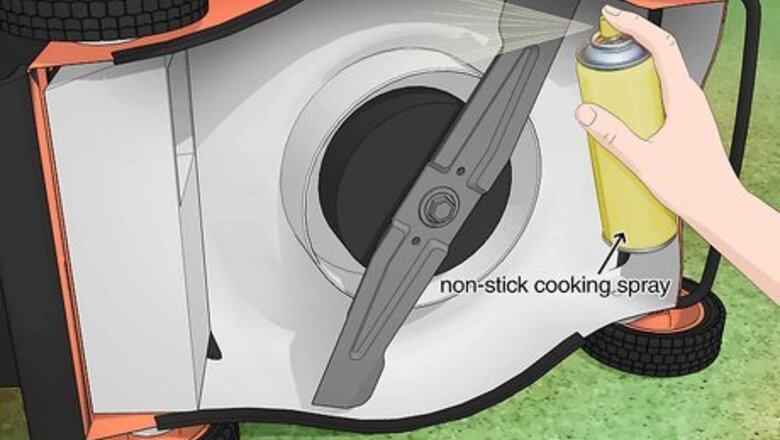
views
- Remove the spark plug and scrape off caked-on grass from underneath the mower deck using a pry bar.
- To prevent grass buildup from sticking to your mower, spray the deck with non-stick cooking spray, silicone lubricant, or a rust protectant.
- Mow regularly at high throttle when your grass is dry to reduce buildup. Switch to high-lift blades if your mower is compatible.
Applying a Protective Coating
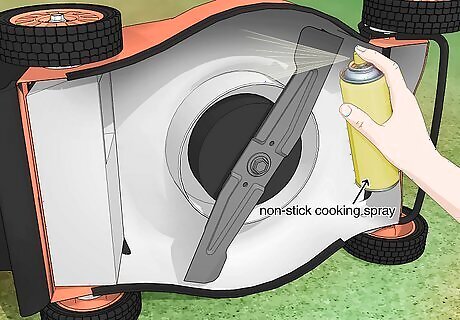
Spray the deck with non-stick cooking spray for an easy solution. Using cooking oil to coat your mower deck is a cheap, short-term solution that helps reduce grass buildup and makes it easier to scrape the grass away when it accumulates. If you don't have a non-stick cooking spray, pour some vegetable oil onto a clean rag and rub it onto your mower deck.
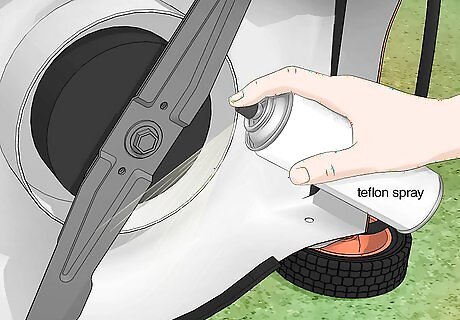
Apply a commercial lubricant spray to your deck for a more lasting fix. Graphite, silicone, or Teflon sprays and floor wax are all effective lawn mower deck lubricants. Use your commercial lubricant spray of choice to cover the entire underside of a clean, dry deck, then let dry as directed. The effect is similar to cooking spray but should last longer.
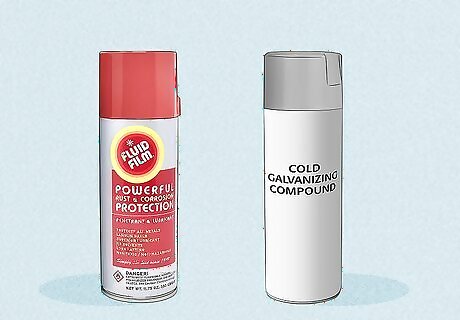
Try a rust protection product to keep your blades sharp and deck clump-free. If you tried a lubricant and were unsatisfied with the results, a rust protectant may be just the thing to stop frustrating grass buildup in its tracks. Follow the label on your rust protectant of choice to ensure you apply the solution to your mower deck properly. There are countless rust protection products on the market, but the following are among the most popular: A lanolin-based product such as Fluid Film leaves a non-drying coat on your mower deck that helps grass to slide right off. Some people swear by it, while others find that grass sticks even more to this coat, so test it on a small patch first. Cold galvanization compound is a highly water-resistant treatment for unpainted metal surfaces. This is a good choice in wet climates, but dirt and debris may still wear it down sooner than the label suggests. Other heavy-duty rust protection products have mixed reviews, though POR-15 is one of the better options.
Changing Your Mowing Approach

Mow dry grass to avoid clumping. Whenever possible, mow the lawn when it’s dry. Morning dew or recent rain can make the grass clump and stick to your lawn mower. Wait to mow your lawn until a day or 2 after it rains, as grass holds internal moisture even when it feels dry. Your lawn will likely be driest mid-day, making it the best time to mow.
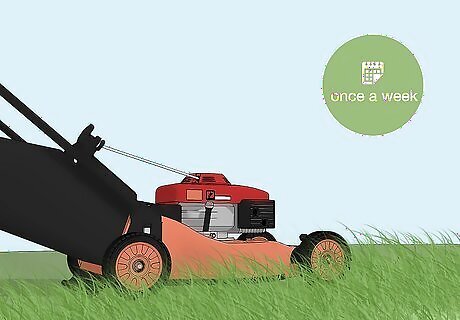
Mow around once a week. The longer the grass clippings, the more likely they are to clump. Cutting up to 1/3 of the grass’s height will help reduce frustrating grass buildup from accumulating under your mower deck.
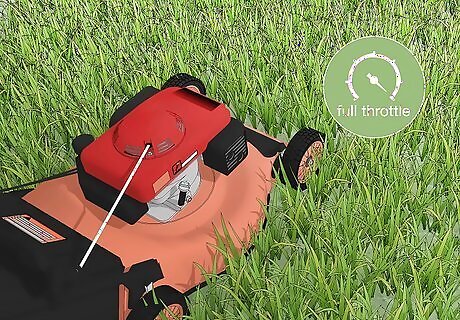
Run the mower at full throttle. Most modern mowers are designed to run at full throttle for the duration of their use. Running your lawn mower at slower speeds makes for a messier cut, as well as reduced airflow which can make it difficult for your mower to eject grass clippings.
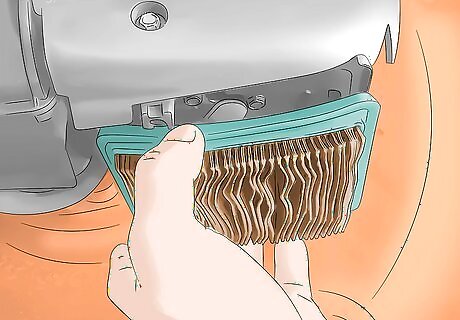
Maintain the mower to keep it in good, working condition. The longer you wait between cleanups, the harder the job will be. Check your mower deck regularly to clean off any grass buildup, and make sure that all parts, like the blades and air filter, are in good condition. Look out for clogged air filters in particular, as they can increase grass buildup. Inspect mowers used for small home lawns (once or twice a week) at least once a month. Check mowers that experience heavy use (several days a week) once every 1-2 weeks.
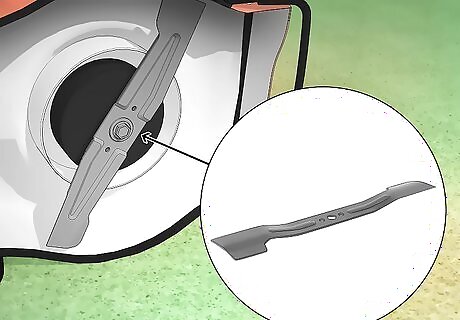
Switch to a high-lift blade. If grass buildup is still a problem, switching to a high-lift mower blade may be a good option, as they increase airflow and eject the grass clippings with more force. Consult your user's manual to determine which brand and make of high-lift blades are compatible with your lawnmower model. Lawnmowers with mulching blades are low to the ground and most vulnerable to accumulating grass buildup. High blades are a great switch, as mowers with low blades are bad for lawns, as they scalp the dirt and tear the grass out by the roots.
Cleaning Off Grass Buildup
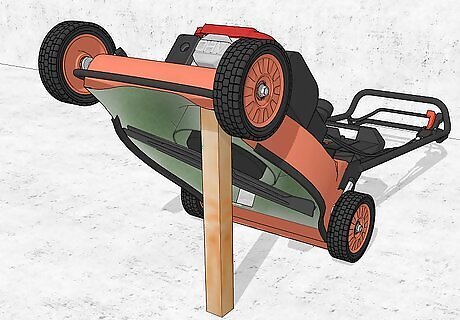
Access the undercarriage of the mower by lifting the front end. Grab the mower from the front end and prop it up using a mower lift or a piece of wood. Secure your mower in an upright position to prevent it from tipping over and possibly injuring you. Keep the gas tank and oil fill openings on the upper side when tilting your mower to avoid unwanted spillage. Emptying the gas tank before you begin reduces the risk of a spill altogether. If your mower is electric, there is no risk of spillage and you can tip the mower any way you like. For ride-on mowers, it is probably easiest to drive the machine up onto ramps to access the underside of the deck. You can also remove the deck for cleaning: see your owner's manual for specific instructions for your particular machine.
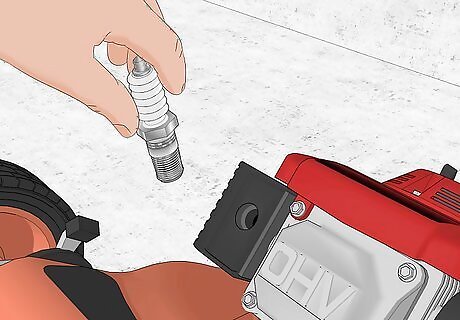
Remove the spark plug. Find the spark plug, grab the cap, and pull it off. Then, use a spark plug wrench to unscrew and detach the plug. Turning the lawn mower's blade by hand can start the engine, making it critical to remove the spark plug or disconnect the attached wires before handling the underside of the lawn mower. If your mower is electric, you can either unplug it (if it's corded) or remove the battery (if it's cordless). Detach your mower’s blade according to your user's manual for additional safety.
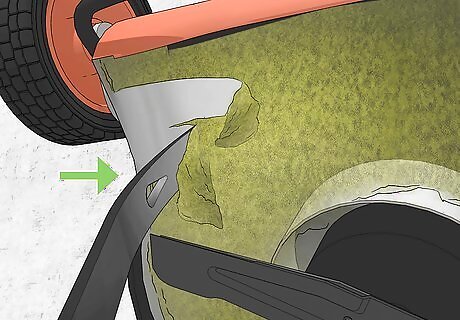
Scrape off caked-on grass using your hands or a pry bar. Put on heavy-duty gardening gloves and remove large clumps of grass by hand or use a large, flat pry bar. Once you’ve dealt with the bigger clumps, scrape the remaining grass out with a metal putty knife or wire brush. If the grass is hardened and difficult to scrape off, wet the underside of the deck using a hose to help loosen things up.
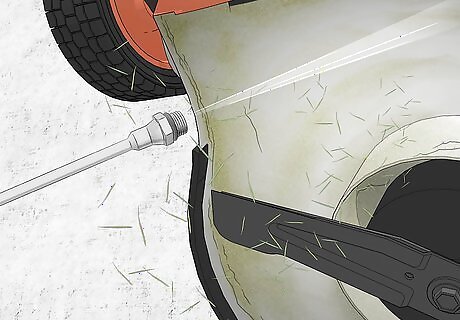
Blow off any remaining grass with an air compressor. After scraping, use an air compressor with a nozzle or wand to blow away any pesky loose grass bits. Going over your mower deck with an air compressor ensures a thorough, grass-free clean.
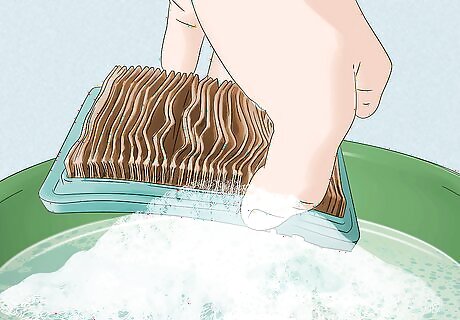
Wash a clogged air filter with soap and water. Locate and remove your mower's air filter according to your user’s manual and check if it needs replacing. If it’s in good condition and is washable, use your air compressor on a low-pressure setting to gently blow off grass and debris, taking care not to tear the filter. Then, add a small amount of dish or degreasing soap in a bucket of water and use it to wash the filter thoroughly. Electric mowers don't have air filters, so this task will not apply. Use an air hose to help speed up the drying process. Let the filter dry completely—do not reinstall the air filter wet. If you’re unsure whether your mower’s air filter can be washed, check your user’s manual.
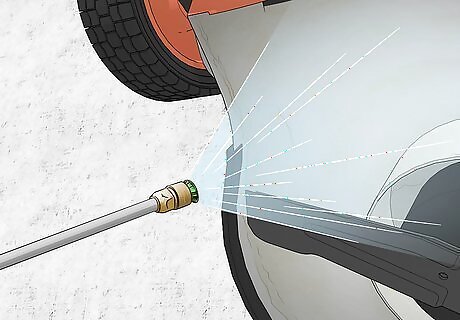
Spray the mower deck with a pressure washer if it’s still dirty. If hand scraping isn’t cutting it, spray the underside of the lawn mower with a pressure washer. Leave the mower propped up using a mower lift or piece of wood and let it dry before continuing to the next section. You can also spray your mower deck with a garden hose, though it won’t be as effective as using a pressure washer. Water can interfere with the air filter or other mechanisms, especially on the sides or top of the mower. Though the underside of your mower is usually designed to withstand occasional washing, it’s best to check your manual if it’s waterproof before pressure washing. If you have an air compressor, use it on the mower deck to speed up the drying time.




















Comments
0 comment